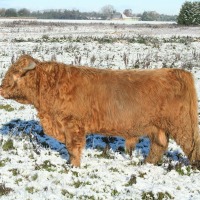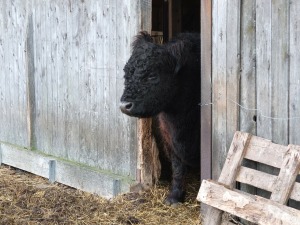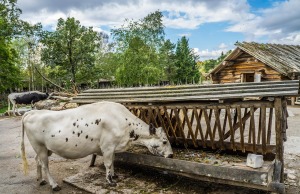

Reduce Winter Stress & Increase Farm Production
 Posted by SLN Staff on Nov 24th, 2014 | Comments Off on Reduce Winter Stress & Increase Farm Production
Posted by SLN Staff on Nov 24th, 2014 | Comments Off on Reduce Winter Stress & Increase Farm Production 

Winter has arrived early this year in the United States. Snow and frigid temperatures may cause animals to become stressed and also influence farm production. Cold weather may also give rise to health concerns for animals and so it may increase the risk of losses and healthcare costs for farmers. During the winter, you should take a few precautionary measures that we have already discussed in our previous blog titled Cattle Management – 5 Tips for Winter. In this blog, we will show you how to improve your livestock health through maximizing the use of nutrition, minimizing stress which would in turn maximize your farm production even further.
In addition to providing shelter and windbreaks in your pasture, below are some points given to improve your cattle health this winter.
1. Supplement with high quality forage and fodder
 During the cold winter season, your herd will need extra energy to stay warm, and therefore, you will have to provide them with higher quality forages or supplement them with protein based feed and grains. Your herd may not eat enough food to meet energy requirements in cold weather. Animals with winter coats and fur tend to do well in cold weather until the temperature reaches the critical point. If the weather is wet or windy, and if your animals get wet, the critical point may be at a higher degree. Studies show that with each degree drop in temperature below the critical temperature, a cow’s energy requirement increases by one percent.
During the cold winter season, your herd will need extra energy to stay warm, and therefore, you will have to provide them with higher quality forages or supplement them with protein based feed and grains. Your herd may not eat enough food to meet energy requirements in cold weather. Animals with winter coats and fur tend to do well in cold weather until the temperature reaches the critical point. If the weather is wet or windy, and if your animals get wet, the critical point may be at a higher degree. Studies show that with each degree drop in temperature below the critical temperature, a cow’s energy requirement increases by one percent.
For cattle with dry winter fur, the critical temperature is 32 degrees F and with a dry heavy winter fur this temperature drops to 19 degree F.
Table 1. Example of effect of temperature on Energy Needs
Extra Feed Needed
| Temperature | Extra TDN Needed* | Hay (lbs/cow/day) | Grain (lbs/cow/day) |
| F | 0 | 0 | 0 |
| +30F | 0 | 0 | 0 |
| 10F | 20% | 3.5-4 | 2-2.5 |
| -10F | -40% | 7-8 | 4-6 |
(Table Credit: fyi.uwex.edu)*TDN – Total Digestible Nutrients
2. Separate thin cows and calves
 During the winter, it is important that you maximize the use of your feed and reduce feed waste. All of your animals may not need equal amounts of feed. The animals who are fully adults and have winter fur on, may need less food to stay warm than those with less body fat and body hair. So, separate the group of animals that are thin or young ones that need extra energy and feed them separately. If you do not provided enough energy, this group of cows can enter calving in poor body condition, which can lead to difficulties calving, poor colostrum, lower milk production, and poor conception rates. Calves may also suffer from lack of nutrition and become thin or sick. (fyi.uwex.edu)
During the winter, it is important that you maximize the use of your feed and reduce feed waste. All of your animals may not need equal amounts of feed. The animals who are fully adults and have winter fur on, may need less food to stay warm than those with less body fat and body hair. So, separate the group of animals that are thin or young ones that need extra energy and feed them separately. If you do not provided enough energy, this group of cows can enter calving in poor body condition, which can lead to difficulties calving, poor colostrum, lower milk production, and poor conception rates. Calves may also suffer from lack of nutrition and become thin or sick. (fyi.uwex.edu)
3. Provide extra insulation & shelter
Hair coat on animals provide them insulation and protect them from cold, but wet, muddy or windy conditions can impact degree of cold stress and affect feed intake requirements. Air pockets between the hair fibers are a source of insulation and can actually decrease dry matter intake requirements. Therefore, be careful not to force cattle into barns or enclosures during storms. Enough wind breaks and shelters are needed for animals while grazing outside in the winter. Plant trees and put up fences for them to protect them from wind and storms. Also provide padding and such for young ones to rest.
4. Supply feed in the late evening and earlymorning
Animals start to produce incremental heat in their body soon after you feed them and it reaches its maximum 4 to 6 hours after they have been fed. Therefore feeding them late in the evening will help ruminant animals to stay warm at night when they chew their cud and start the fermentation process overnight.For all natural feed, you may obtain a DIY system to grow your own fodder indoors during the winter or anytime, all year round. Growing fodder from grains allow you to supply high quality, high protein, high calorie feed, necessary for increasing body heat in animals and staying comfortable during winter.
For more information, contact our office or click here to book a meeting with us.
Source: Sustainable Livestock Nutrition






